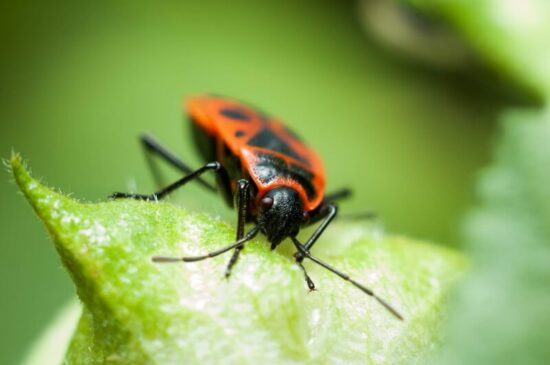Boxelder bug bites are commonly misunderstood. Some people think they’re dangerous, and others think these insects don’t bite at all!
So which is it?
This guide will cover everything you need to know about boxelder bug bites, and what you should do if you happen to get bit.
Table of Contents
Do Boxelder Bugs Bite?
Also known as elder bugs or maple bugs, boxelder bugs are unique pests that like to live on trees. They can swarm around boxelder, ash, and maple trees, developing massive colonies. The bugs are usually dark brown or black base color accompanied by vibrant red accents.
If you’re unlucky enough to disturb a nest, boxelder bugs can swarm around you, making it feel like you’re being attacked!
Don’t worry, swarming boxelder bugs aren’t out to get you. In most cases, they’re simply looking for warmth and mistake you as a place of protection.
But do boxelder bugs bite?
Boxelder bugs typically don’t bite, and they certainly don’t go out seeking to bite humans like some other insects. However, bites can occur if they feel threatened.
Like most insects, the boxelder bug will do what it can to protect itself and its colony if under threat. But outside of that, these pests typically stick to themselves.
A boxelder bug bite usually isn’t a huge deal if one does end up biting you. That’s because boxelder bugs don’t have teeth or even pincers to cause harm.
Boxelder bugs are what entomologists call “true bugs.” These insects have unique mouths for feeding. Called the proboscis, it’s a thin, extending tube that they use to pierce plants and access sap.
Think of it as what you see on a mosquito. However, the beak-like mouth on a boxelder bug is relatively delicate. It’s for piercing soft plants rather than human or animal skin.
All that said, the bugs can use the proboscis to “bite” you. When threatened, that tube-like mouth turns into a weapon of defense. They’ll use it to pierce the skin of potential predators and hopefully scare them off.
When that happens, the insertion point may bleed a bit. It can also experience swelling and irritation. However, it’s akin to a mosquito bite and usually isn’t a significant cause for concern.
Are Boxelder Bugs Dangerous?
Don’t let the unique appearance of the boxelder bug fool you. In nature, bright colors often indicate poison or danger. As a result, the vibrant accents on this insect’s back often raise some red flags among cautious individuals.
But for humans, boxelder bugs aren’t dangerous in any way. Their bite might sting a bit and experience irritation. But outside of that, you don’t have to worry.
Boxelder bugs aren’t poisonous. They don’t produce toxins that you could be allergic to or have any poisons that could shock the system. These bugs aren’t known to transmit any diseases or parasites, either.
The biggest concern is slight inflammation, but that’s just your body’s natural response to their needle-like mouths piercing the skin.
Expert Tip: Bites are subtle, and they usually feel like a simple sting. But that sensation only occurs if the bite breaks the skin. In some cases, people will experience a bite without even noticing!
What Do Boxelder Bug Bites Look Like?
If you suspect that you’ve been bitten by a boxelder bug, look for a small, reddish dot.
Expert Tip: Remember that these insects “bite” you by piercing your skin with their tubed mouths. They don’t chomp down or even have any teeth that could break the skin. As a result, bites are very localized.
Other insects might leave a series of dot-like bite marks, but that’s not the case with boxelder bugs. It’s usually a single dot.
The spot may have a slight tinge of blood. As it heals, inflammation will begin. That causes the dot to turn into a small raised bump.
The bump will have a reddish-pink color and similar symptoms to swelling. This reaction isn’t special to boxelder bug bites. It’s a similar response you’ll experience with a mosquito bite, and it’s your body’s way of healing the pierced skin wound.
Eventually, the bite may start to itch. Once again, the itchiness is usually just a product of the histamines your immune system releases to promote healing.
Boxelder Bug Bite Treatment
Have you gotten on a boxelder bug’s bad side and experienced a bite? While you don’t have to worry about any significant pain or dangerous reactions, the irritation after the bite can be a hassle.
Luckily, boxelder bug bite treatment is pretty straightforward. Just follow these steps.
1. Clean The Area
The first thing you should do is clean the affected area. Doing so will remove any germs the boxelder bug might have left behind as it bit you. Use a mild soap and water to take care of the job.
If you want to be extra careful, you can apply an antiseptic spray.
2. Apply A Compress
To reduce swelling, consider applying a cold compress. This step isn’t absolutely necessary, but it can make a difference in promoting healing.
Wrap a few ice cubes in a soft towel and apply the cool fabric to the skin for about 10 minutes.
3. Keep The Injury Elevated
If you’re at home, consider raising the part of the body carrying the bite. If it’s on your leg, kick up your feet and relax!
Like the compressing step before, this one isn’t paramount. However, elevation can reduce swelling and encourage faster healing.
4. Take Antihistamines Or Anti-Inflammatories
Simple over-the-counter antihistamines and anti-inflammatory products are another way to keep swelling and inflammation under control.
Antihistamines like Benadryl combat the immune response that causes inflammation. Meanwhile, anti-inflammatories like ibuprofen reduce swelling and help control any discomfort you might feel.
5. Resist The Urge To Scratch
As your boxelder bug bite heals, do everything you can to not scratch it. This step can be challenging as your immune system releases histamines, and the bite swells up. If you have to, try applying a small bandage over the wound.
Scratching can do more harm than the bite itself. It prevents the injury from healing and can spread more bacteria, leading to the possibility of infection.
Can They Harm Your Pets?
Boxelder bugs aren’t out to get your pets. But if your cat or dog agitates the bug, they won’t hesitate to bite them as they would bite you! Thankfully, these bugs aren’t any more dangerous to your pets than they are to you.
That said, they do present a unique problem that you might have to deal with if you have boxelder bugs in your backyard. These insects are a common target for curious cats and dogs with a penchant for eating bugs. Prepare for possible issues if you find your pet chowing down on crunchy boxelder bugs.
There are two issues when it comes to your pets eating these bugs:
- The smell
- Possibility of pesticides
Boxelder bugs are surprisingly smelly. Their feces are downright rancid! The smell is a defense mechanism that deters would-be predators.
If your dog or cat bites down on the bug, the smelly and foul-tasting poop will get everywhere! As a homeowner, the stuff is gross. It can get on fabrics, leaving behind a stain and awful smells.
As a pet-owner, the bug’s poop is particularly problematic because it causes some negative side effects on cats and dogs. Many will start vomiting. If that doesn’t happen, they’ll likely drool excessively as they try to eradicate the awful taste and smell.
Fortunately, these symptoms are usually mild. If your pet ate many bugs, it can persist and cause dehydration, so you might want to visit a vet for assistance if vomiting continues.
Another potential cause for concern is pesticides. Boxelder bugs use their mouths to pierce plants and suck out their sap or nectar. Some gardeners use strong chemical-based fertilizers or pesticides.
Boxelder bugs that feed on those plants frequently will develop a build-up of a decent amount of chemicals in their body. When your pet eats the bug, they inadvertently ingest the chemicals.
Expert Tip: The good news is that the amount of chemicals isn’t enough to kill your pet or cause a significant reaction. The bad news is that it can cause vomiting and other mild problems. The reaction is temporary, but always keep an eye on your pet and take them to the vet if issues persist.
Where Can These Insects Be Found?
Boxelder bugs are pretty widespread. They’re native to the western side of the United States, occurring as far west as eastern Nevada.
They can occur in parts of Canada and the eastern United States. You can find them anywhere boxelder trees occur naturally. They can live on maple and ash trees as well. Some even favor fruit trees.
However, they stick to areas that can grow boxelder trees naturally.
You’re most likely to see boxelder bugs in the spring and summer months. They emerge from hibernation in the early spring and spend the warm parts of the year feeding on their host trees before the winter season rolls around.
Conclusion
As you can see, boxelder bug bites aren’t dangerous. However, understanding why these bugs bite and what you can do about it will be helpful if you live in an area with many of these critters.
Let us know if you have any questions about the guide above. We’re always happy to help.


